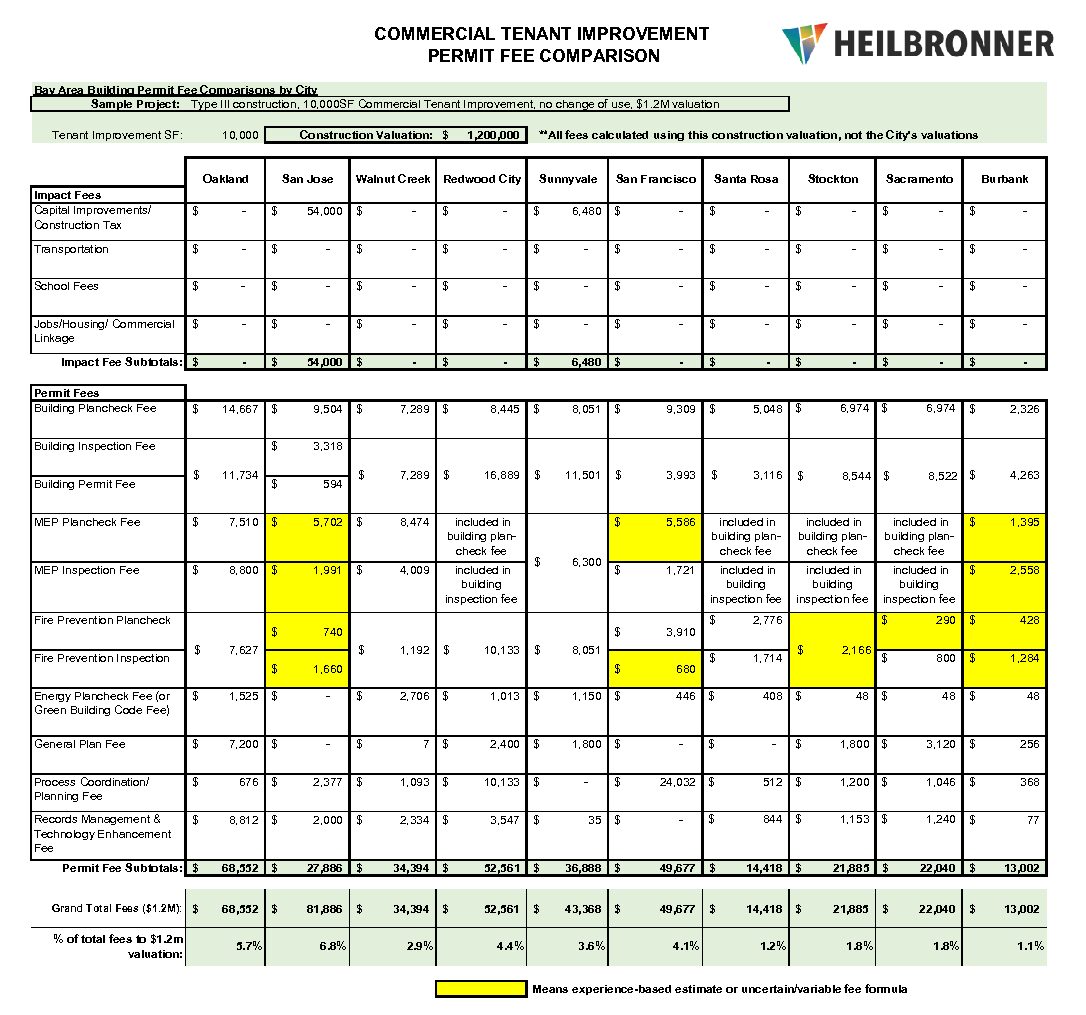This is the third in a series of 3 analyses comparing development “Impact Fees” and Building Permit-related fees between 10 California cities from around the state where we’ve currently or recently had projects. The first study used a new warehouse build as the prototype project; the second study a 200-unit multi-family build, and this final study uses a commercial tenant improvement project as the basis for the fee comparison.
Heilbronner AM will prepare an Agency Fee Schedule that provides estimates for all entitlement, permit and other agency fees – tailored specifically to your project regardless of location. Contact Us if you’re interested in obtaining an agency fee estimate for your development.
Tenant Improvement Project Fees
In our efforts to compare permit fees of 10 cities we did not forget the tenant improvement (T.I.) type of project, theoretically the easiest to permit with the least expensive fees.
The tenant improvement fees do not consider modifications to the existing building shell or site for issues like ADA compliance, energy code upgrades or life safety improvements triggered by the T.I. project. It is, however, getting harder and harder to “grandfather” old improvements during the permitting process, particularly when under scrutiny by fire agencies. Clearly these types of issues increase construction costs and presumably the “value” of the project which can drive higher fees.
A notable difference in this comparison is the absence of developer impact fees in nearly all of the jurisdictions. A couple of the cities surveyed still apply a ‘construction tax’ – which is akin to an impact fee – on tenant improvement projects, but as a rule of thumb, developer impact fees will only be charged if there is a change to a more ‘intensive’ use, or an increase in floor area at the existing structure. Without either of those ingredients, there is no new ‘impact’ on public services to warrant a fee.
Our third comparative fee study is based on a commercial tenant improvement project. Depending on location, fees range from $13K to nearly $82K on the same design parameters for a $1.2M tenant improvement project.
Method for the Comparison
The fee comparison uses a prototype project as a basis for its fee calculations, in this case a 10,000 sf commercial tenant improvement project valued at $1.2m in an existing building, no change of use or modifications to the building, as described in the graphic below.
With each of our studies the specific fee categories chosen are based on the most common types of agency fees found consistently in cities across the state. The fees included are not a complete representation of the fees applied to a project in any given city, but we aimed to include the most prominent fees in the ‘impact fee’ and ‘building permit’-related fee categories. Fees relating to entitlements, other departments, utilities, or agencies may be addressed in future fee studies.
The fee comparison is not perfect, but it should be representative of how much individual fees can differ between municipalities for the same project, assuming the same valuation.
Construction Valuations are Not Uniform Across Jurisdictions
For the uninitiated, Impact Fees and Building Permit fees (and their relatives in other departments) are generally based on the project’s Construction Valuation and Occupiable Floor Area (excluding spaces like parking garages, and storage – in some cases), or a combination thereof. For a prototype project comparison like this, Floor Area is a constant regardless of jurisdiction, but the same is not the case when it comes to Construction Valuation. It is not common for every city to use the same (or even similar) construction valuation formula, even if all other categorical inputs (occupancy, building type, floor area) are the same.
For a more detailed discussion of the jurisdictional variation in Construction Valuations, see our Building Permit Fee Comparison #1 – New Warehouse.
Additional Notes regarding the Fee Study
This comparison is based on FY22-23 fee schedules obtained from the represented cities.
All estimates are based on the best information available at the time, and in some instances, past experience.
Many cities, especially larger cities, also have other significant fees that apply to specific/area plans or other geographically defined ‘assessment districts.’ In cities where these regional fees are not applied to all property within city boundaries, or have high variance between neighborhoods, the fees were excluded as they would not fairly represent the cities for comparative purposes.
Further details regarding the methods used for the comparison may be provided upon request.
A version of this comparison was originally issued with our Newsletter on 9/27/2023. To be added to our mailing list contact us or sign up here.


